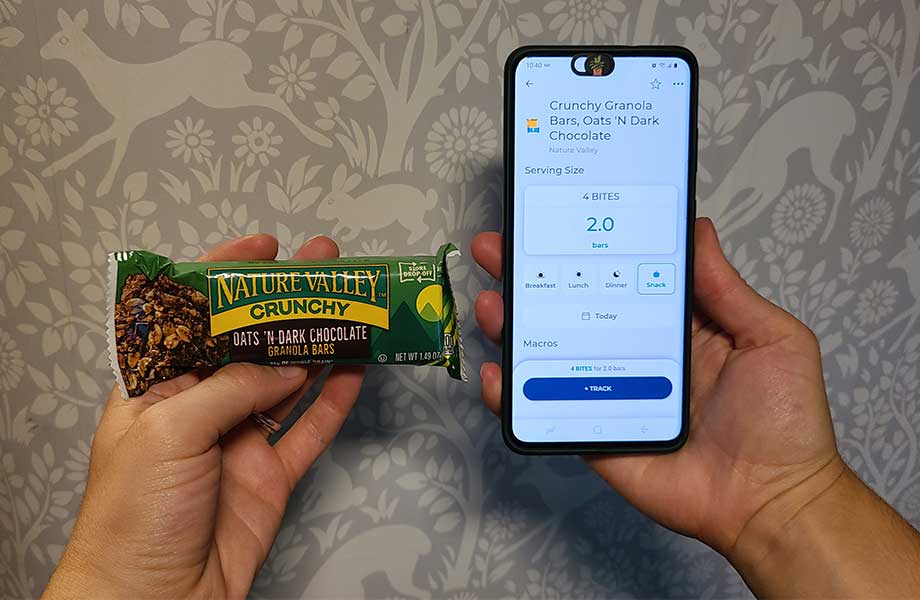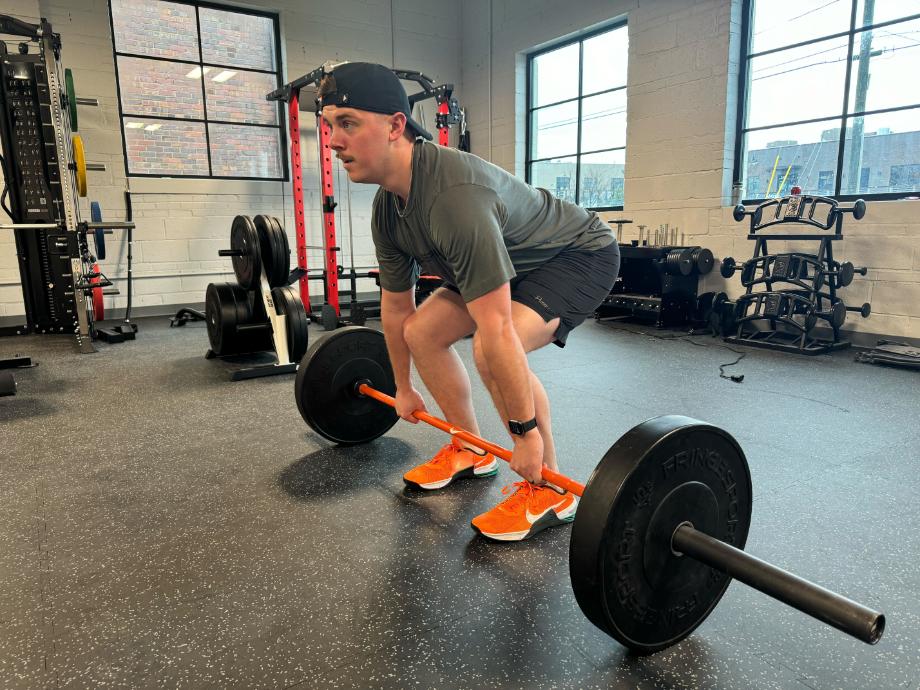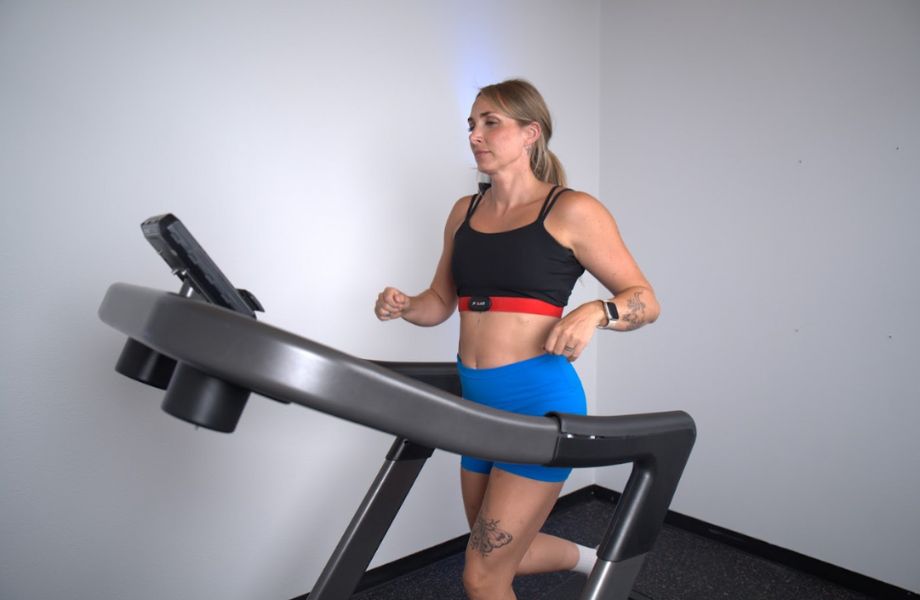We test and review fitness products based on an independent, multi-point methodology. If you use our links to purchase something, we may earn a commission. Read our disclosures.
How many calories do you burn in a day? The answer varies depending on sex, age, weight, and activity level. If you’re trying to lose weight or build muscle, understanding the number of calories you eat and burn (aka thermogenesis) can help you meet your health and fitness goals.
Keep reading to learn how to calculate your resting metabolic rate (RMR) and total daily energy expenditure (TDEE) to maximize your effort in the gym.
What Are Calories?
A calorie is a unit of energy. Scientifically speaking, it’s the amount of energy needed to raise water temperature by one degree Celsius. However, when we’re talking about food, a calorie is actually a kilocalorie (kcal) and is the amount of energy a food or drink contains. Your body burns calories as an energy source.

Food packaging lists nutritional information that includes total calories and where those calories come from, namely the primary macros—fats, protein, and carbs. The United States Department of Agriculture (USDA)¹ uses the following guide for calorie and macronutrient breakdown:
- Protein: 4 calories per gram
- Carbohydrate: 4 calories per gram
- Fat: 9 calories per gram
The calorie source determines the food’s caloric density or calories per unit of weight. For example, an average carrot weighs 60 grams and contains 25 calories from carbohydrates. An equal amount of chocolate contains 303 calories coming from fat and a high sugar content. When you know what you’re putting in your body and where those calories come from, you can make more informed decisions about your food.
The USDA² suggests the following calorie intake based on age and sex:
| Female Age 19-30 yrs. | Female Age 31-59 yrs. | Male Age 19-30 yrs. | Male Age 31-59 yrs. | |
| Average Required Calories per Day | 1,800-2,400 | 1,600-2,200 | 2,400-3,000 | 2,200-3,000 |
However, your daily needs may vary based on your activity level and many other factors.
What Is Calorie Counting?
Calorie counting is a weight management method used to gain, lose, or maintain weight. It requires counting every calorie eaten to sustain a specific calorie intake goal. Depending on your goals, you can adjust your calories accordingly:
- Weight maintenance: Calories in = calories out
- Weight loss: Calories in < calories out
- Weight gain: Calories in > calories out
By tracking, you can tell if you’re eating the right amount of calories to meet your health and fitness goals or if you should consume fewer calories. If the thought of tracking your calories sounds overwhelming, don’t be shy about consulting a professional like a registered dietitian nutritionist (RDN). There are also plenty of apps you can try.

RELATED: Best Calorie Counter Apps
How Do Calorie Calculators Work?
Calorie calculators use predictive equations³ to estimate calorie needs based on information such as your age, current weight, height, and activity level. You can use them to determine how much food you need to eat and how many calories you need to burn each day.
However, it’s important to know what the calculator is estimating. For example, one calculator may gauge your basal metabolic rate (BMR)—e.g., Harris-Benedict equation, Mifflin-St. Jeor, or Katch-Mcardle formula—while another may estimate your resting metabolic rate (RMR). Other calorie calculators may offer multiple estimates so you know how many daily calories you need to gain, maintain, or lose weight. These calculators typically estimate your total daily energy expenditure (TDEE), which includes calories burned, exercising, and doing everyday tasks like washing dishes or folding laundry.
BMR Calculators
Harris-Benedict Equation
- Men: 66.4730 + 13.7516 x weight in kg + 5.0033 x height in cm – 6.7550 x age
- Women: 655.0955 + 9.5634 x weight in kg + 1.8496 x height in cm – 4.6756 x age
Mifflin-St Jeor Formula
- Men: (10 x weight in kg) + (6.25 x height in cm) – (5 x age in years) + 5
- Women: (10 x weight in kg) + (6.25 x height in cm) – (5 x age in years) – 161
Katch-Mcardle Formula
- BMR = 370 + (21.6 x Lean Body Mass [kg])
- LBM = (Weight [kg] x (100 – Body Fat %) / 100)
Calorie calculators are a fast way to estimate how many calories you might burn or need to eat to achieve your goals. To get the most benefit from a calorie calculator, you’ll need to track all the food you consume.
RELATED: Walking Calorie Calculator
Amount of Calories Burned in a Day With Exercise
TDEE, or total daily energy expenditure, is the total amount of calories you burn per day with exercise. An estimate of your TDEE can help you know if you should increase your exercise time and/or adjust your calorie intake.
If you’re trying to lose weight, your TDEE should be higher than your total calories eaten. For example, if you want to lose one pound per week, you need a 3,500-calorie total weekly calorie deficit. That means you need a 500-calorie deficit each day. Knowing your TDEE, you can adjust your exercise time or incorporate strength training or high-intensity interval training to burn an extra 200 calories while reducing your calorie intake by 300 calories to create your needed 500-calorie deficit.

Exercise is important, but it’s not the only way to increase energy use and gain health benefits. The amount of calories you burn during daily activities matters, too. Take the stairs instead of the elevator, or park further from the grocery store entrance. Get up and walk the stairs or down the hall once an hour while at work to move your body more. And, of course, when it comes to exercise, mix a little aerobic exercise and cardio into your regularly scheduled resistance training regimen.
Amount of Calories Burned in a Day Without Exercise
Your RMR, or resting metabolic rate⁴, is the number of calories your body needs to sustain itself in a resting position. It doesn’t include calories used in daily activities, like walking around your house, preparing a meal, or doing yard work. This is the base amount of calories you need to survive.
Your age, current weight, and fitness level influence your REE. Body composition and how much muscle versus body fat you have determines how many calories you burn at rest. For example, men (who generally have more muscle mass) have higher RMRs than women of a similar age and fitness level.
What Activities Burn the Most Calories?
Before jumping into the activities that burn the most calories, remember to always keep an eye on the intensity of your physical activities. A 155-pound person running at 5 mph burns around 288 calories in 30 minutes, while a person running at 7.5 mph for 30 minutes burns 450 calories—intensity matters.

Using the ACE Fit Physical Activity Calorie Counter⁵, here are approximate estimates of how many calories a person burns based on their body weight (not sex or any other factors that can affect your total calorie burn):
Calories Burned Per Activity
| 130 pounds | 160 pounds | 200 pounds | |
| Running (5 mph) | 235 | 290 | 362 |
| Running (7 mph) | 339 | 417 | 521 |
| Running (10 mph) | 471 | 580 | 725 |
| Swimming (casual) | 206 | 254 | 317 |
| Swimming (vigorous) | 294 | 362 | 453 |
| Cycling (5.5 mph) | 117 | 145 | 181 |
| Cycling (12-13 mph) | 235 | 290 | 362 |
| Hiking | 176 | 217 | 272 |
| Jump roping (slow) | 235 | 290 | 362 |
| Jump roping (fast) | 353 | 435 | 544 |
| Rock climbing | 235 | 290 | 362 |
RELATED: Best Fitness Trackers
How Many Calories Do You Burn in a Day? Final Thoughts
How many calories you burn per day varies from person to person. Calorie calculators can help you determine how many calories you need each day to meet your health, fitness, and weight loss goals. But keep these facts in mind:
- Height, weight, sex, and age affect how many calories you burn at rest or while doing daily activities.
- Exercise increases your daily calorie burn, but it’s not the only way to increase your energy use.
- Increasing your activity levels when you’re not exercising by taking the stairs, going for short walks, and moving your body regularly throughout the day can help you increase your energy use.
- If you want to increase the calories you burn while exercising, try increasing your exercise intensity by running faster or adding weight to your routine.
How Many Calories Do You Burn in a Day? FAQs
How many calories does 10,000 steps burn?
How many calories 10,000 steps burn depends on what you’re doing in those 10,000 steps. You’ll burn more calories running 10,000 steps than you will walking 10,000 steps. Let’s say someone walks at 3 mph for two hours, resulting in around 10,000 steps. If the person weighs 160 pounds, they’ll burn 478 calories. The same person can cover the same ground and still do 10,000 steps but would burn 725 calories if running at 6 mph.
How many calories should I burn a day with an Apple watch?
Apple watches have a move goal and exercise goal. According to Apple support⁶, “Every full minute of movement that equals or exceeds the intensity of a brisk walk counts” toward your move goal. Once again, how many calories you burn in a day with the Apple watch will depend on your goals and your height, current weight, sex, and other determining factors.
RELATED: Oura Ring vs. Apple Watch
Your move goal will depend on the calorie deficit you want to achieve. For example, if you’re trying to create a 500-calorie deficit, you’d need at least 300 calories from movement to go with your 200-calorie exercise goal. You can always adjust your goals if they’re too high or low. Burning 200 calories from exercise is a good starting goal.
How many calories do I need to burn a day to lose 2 pounds a week?
One pound roughly equals 3,500 calories. To lose 2 pounds per week, you need a calorie deficit of 7,000 calories. Divide 7,000 by 7, and you need a 1,000-calorie deficit per day to lose two pounds per week. Those calories can come from a food deficit or burning more calories through daily activity and exercise.
How many calories do you burn sleeping?
A 125-pound person will use about 38 calories per hour⁷ while asleep. Multiply that by seven, and you’re looking at 266 calories in a typical night. However, the more you weigh, the more calories you’ll burn while you sleep. Someone weighing 185 pounds may burn as much as 56 calories per hour.
References
- “Food and nutrition information center.” USDA. Date accessed September 30, 2024. https://www.nal.usda.gov/programs/fnic#faq–how-many-calories-are-in-
- “Dietary guidelines.” USDA. Date accessed September 30, 2024. https://www.dietaryguidelines.gov/sites/default/files/2020-12/Dietary_Guidelines_for_Americans_2020-2025.pdf
- Cancello, R., et al. (2018). Analysis of Predictive Equations for Estimating Resting Energy Expenditure in a Large Cohort of Morbidly Obese Patients. Frontiers in Endocrinology, 9. https://doi.org/10.3389/fendo.2018.00367
- McMurray, R.G., et al. (2014). Examining variations of resting metabolic rate of adults: A public health perspective. Medicine & Science in Sports & Exercise, 46(7): 1352-1358. DOI: 10.1249/MSS.0000000000000232
- American Council for Exercise. Physical activity calorie counter. Accessed October 1, 2024. https://www.acefitness.org/resources/everyone/tools-calculators/physical-activity-calorie-counter/
- “Get the most accurate measurements using your Apple Watch.” Apple support. Date accessed October 1, 2024. https://support.apple.com/en-us/105002
- “Calories burned chart by activity and weight, including walking, sports, and everyday activities.” Harvard Health Publishing. March 8, 2021. Date Accessed September 30, 2024.
Further reading

TheTexas All American Barthe first general-purpose barbell produced by Buddy Capps, the company behind the legendary Texas Power Bar. Utilizing a similar construction and material list as the Texas Power Bar, the All American Barbell features a more passive knurl to allow things like barbell cycling. Although the Texas All American Bar isn’t the best bar we’ve reviewed, the price, features, and quality make it a bar that we can easily recommend. Read more

Pre-workout vs. energy drink: which is the better option before your next training session? A nutrition coach explains everything you need to know. Read more

What do you really know about the crunches exercise? GGR’s own Amanda Capritto provides tips for proper form and more! Check it out! Read more

OSO Barbell Collars, now manufactured by Rogue Fitness, are by and large the best barbell collars being made. The hold tight, are extremely durable, and look as good as they perform. We highly recommend any OSO Barbell Collar. Read more
